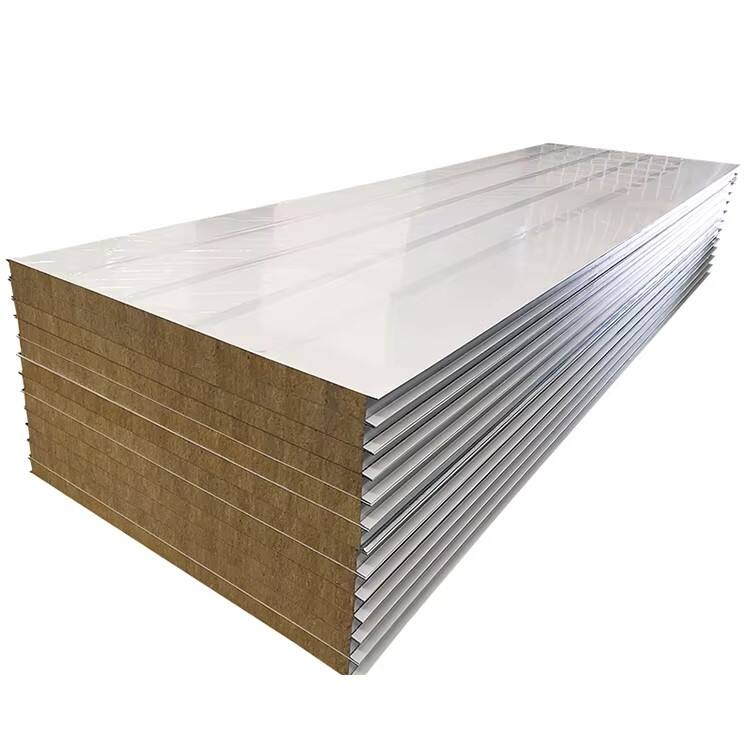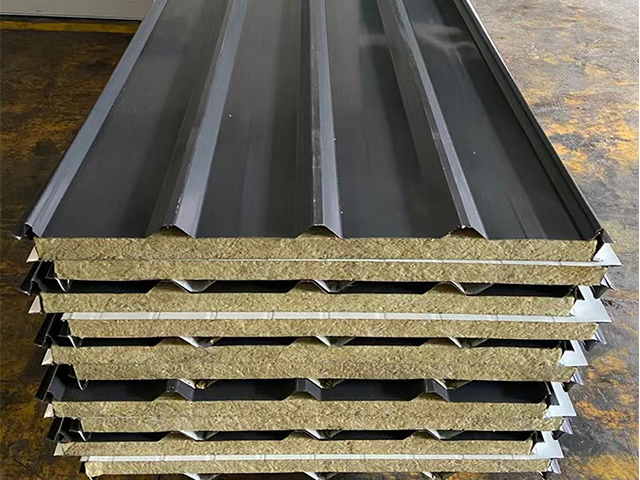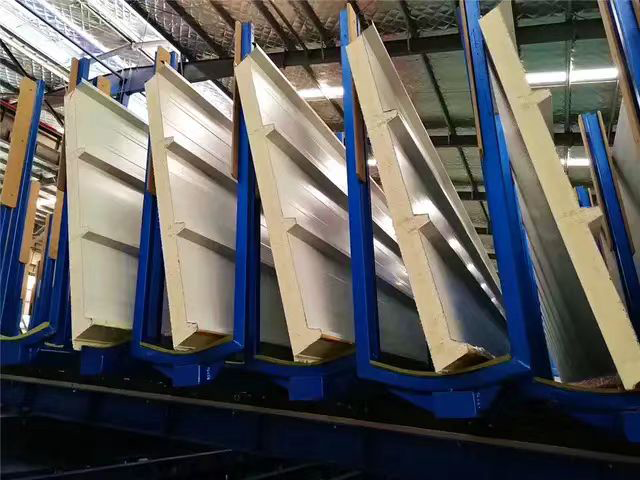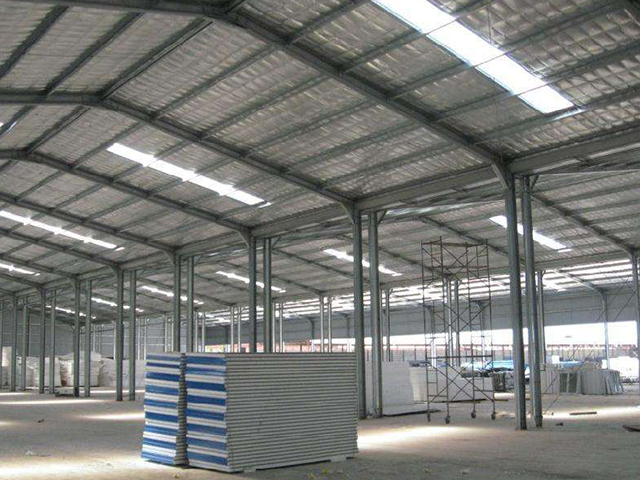The Critical Role of Fire Resistant Building Materials
Industrial and commercial facilities face 23% higher fire risks than residential structures, with material combustibility directly impacting evacuation times and structural collapse rates (Ponemon 2023). Non-combustible cladding solutions like rock wool sandwich panels create critical barriers that slow flame spread, buying occupants up to 60% more escape time compared to combustible alternatives.
How Rock Wool Enhances Fire Resistance in Sandwich Panels
The mineral makeup of rock wool basically consists of melted basalt and slag turned into those interlocking fiber structures, which gives it natural fire resistance properties. When things catch fire, materials like polyurethane or EPS cores tend to let off harmful gases, but rock wool stays strong even when exposed to really high heat, well over 1000 degrees Celsius. The fact that rock wool has this A1 rating for being non-combustible means these panels won't help spread fires during critical moments called flashovers. And we're talking about something serious here since flashovers are responsible for around 80 percent of deaths related to fires according to safety studies.
Real-World Performance: Case Studies in Industrial Buildings
A 2022 retrofit of a chemical storage warehouse using 120mm rock wool panels demonstrated zero flame spread during an accidental fire, confining damage to 15% of the facility. By contrast, neighboring units with EPS cores sustained complete losses within 20 minutes.
Evaluating Fire Ratings: Understanding A1 Non-Combustibility Class
The A1 classification under EN 13501-1 signifies the highest fire safety tier, requiring materials to achieve:
- Zero flame spread in vertical chamber tests
- Heat release below 2 MJ/m²
- No smoke production or dripping debris
Growing Demand for Non-Combustible Cladding Solutions
Stringent updates to the International Building Code (IBC 2021) now mandate A1/A2-rated materials for all high-rise exteriors and industrial partitions, driving a 37% year-over-year increase in rock wool panel adoption across North America and Europe.
Core Properties of Rock Wool Sandwich Panels
Composition and Structural Integrity of Rock Wool Core
Rock wool sandwich panels derive their fire-resistant backbone from compressed basalt or diabase mineral fibers, achieving densities between 80–150 kg/m³. This mineral composition creates a non-combustible matrix capable of withstanding temperatures exceeding 1,000°C while maintaining structural stability—a critical advantage over organic insulation materials that degrade under extreme heat.
Thermal and Acoustic Insulation Performance
Rock wool cores have thermal conductivity around 0.04 to 0.045 W/m·K, which means they stop heat moving through them about 40 percent better than regular concrete walls do. The material's porous nature also gives it good soundproofing capabilities, usually hitting STC ratings between 25 and 30. This helps cut down on all that annoying noise coming from machines and air conditioning units in industrial settings. According to the latest industry reports from 2023, buildings using these materials can save anywhere from 18 to 22% on their energy bills too. Plus, facilities stay within legal limits for workplace noise levels without having to spend extra money on special acoustic treatments.
Durability and Weather Resistance in Extreme Conditions
The special water-repelling properties in rock wool stop it from soaking up moisture even when humidity hits 95%, which is really important for buildings near the coast where corrosion can be a big problem. Steel panels that resist UV damage work together with those interlocking designs to keep things safe from fires, even when temperatures swing wildly between -40 degrees Celsius and 120 degrees Celsius. Most cold storage places need this kind of protection these days actually about 79% of them installed these panels last year according to industry reports. Some real world testing has shown that after sitting through 15 years of harsh conditions in chemical plants with lots of acid in the air, the insulation still performs pretty well with less than 2% drop in how effectively it keeps heat out.
Rock Wool vs. Other Core Types: A Fire Safety Comparison
Comparing Fire Performance: Rock Wool vs. EPS and PU Panels
Looking at fire resistant sandwich panels, rock wool definitely stands above EPS (Expanded Polystyrene) and PU (Polyurethane) options because it just won't catch fire. The numbers tell the story pretty clearly too. EPS starts melting around 200 degrees Fahrenheit or about 93 Celsius, while PU gives off those nasty toxic fumes when things heat up past 437 F (that's roughly 225 C). Rock wool on the other hand keeps holding together even when temperatures reach a scorching 2,150 F (about 1,177 C), according to those thermal stability tests following EN 13501-1 standards. And speaking of ratings, rock wool gets the top mark with an A1 classification for non combustible materials. Meanwhile EPS sits at the bottom end with an F rating for flammability, and PU is all over the place with either B or C classifications depending on who tested it.
Rock wool sandwich panels are particularly effective in places where fire safety matters most, such as chemical processing facilities and data centers. These panels stop flames from spreading quickly and keep smoke emissions below 10% of what's considered acceptable according to ASTM standards. Testing under controlled conditions following GB8624-2022 shows just how much worse EPS panels perform when it comes to fire spread distance they let flames travel about twice and a half times further than rock wool does. Polyurethane insulation might have better thermal properties, around 0.022 W per meter Kelvin compared to rock wool's roughly 0.035 to 0.045 range, but this material burns easily. That makes PU unsuitable for structures needing at least two hours of fire resistance protection.
Ideal Applications: Warehouses, Cold Storage, and High-Rise Buildings
The fire safety hierarchy of core materials directly informs their applications:
- Warehouses: Rock wool’s non-combustible properties meet NFPA 13 standards for storage facilities housing flammable goods.
- Cold Storage: PU dominates low-risk refrigeration units but requires supplemental fire barriers in spaces exceeding 500 m².
- High-Rise Buildings: International Building Code mandates rock wool cores for external cladding in structures over 75 feet (23 m) to prevent vertical fire spread.
Recent projects show a 63% reduction in fire-related insurance claims for industrial buildings using rock wool panels versus PU alternatives (2023 Construction Safety Report). For projects balancing cost and safety, hybrid designs may use PU in non-critical zones while reserving rock wool for firewalls and escape routes.
Compliance with Global Fire Safety Standards and Certifications
Key Regulations Influencing Rock Wool Sandwich Panel Selection
Building codes today are pushing harder for non-flammable cladding options in both industrial and commercial buildings. Take the International Building Code (IBC) as one example it demands fire resistant walls for places where dangerous substances are stored. Then there's Eurocode EN 1996-1-2 which sets out what kind of thermal resistance different structures need to meet. When looking at actual performance data from warehouse fires in 2023, buildings with rock wool panels meeting these standards saw about 72 percent reduction in how fast fires spread compared to those with EPS core materials. This makes a big difference in safety outcomes. For architects working on projects worldwide, checking local fire regulations is absolutely critical. The Chinese GB/T 8624 system, for instance, has much tighter restrictions on smoke density than most other global standards do, something that can impact material choices significantly.
Essential Certifications: EN 13501-1, ASTM E84, and GB8624
Third-party validation ensures rock wool panels meet critical fire-performance benchmarks:
| Certification | Region | Key Metric | Compliance Threshold |
|---|---|---|---|
| EN 13501-1 | EU/International | A1 non-combustibility | Zero flame contribution |
| ASTM E84 | North America | Flame Spread Index (FSI) | ≤25 for Class A |
| GB8624 | China | Total Heat Release (THR) | ≤3 MJ/m² (Grade A1) |
These standards require independent laboratory testing under controlled conditions, including the ISO 9705 room-corner fire scenario. Panels achieving all three certifications typically demonstrate no more than 15% strength loss at 1,000°C—a critical factor for load-bearing applications in multi-story buildings.
Installation and Maintenance for Long Term Fire Safety
Proper installation and maintenance of rock wool sandwich panels directly impact their fire-resistant performance over decades.
Best Practices: Preventing Thermal Bridging and Ensuring Sealing
- Stagger panel joints to eliminate continuous gaps that allow heat transfer
- Apply high-temperature silicone sealants rated for ≥1,000°C at panel edges and penetrations
- Use 6mm-thick steel closure strips for seams in fire-rated walls to maintain integrity
Maintenance Tips to Preserve Fire Resistance Over Time
- Conduct annual visual inspections of sealants using thermal imaging to detect hidden gaps
- Clean surfaces with pH-neutral solutions to avoid corrosion of protective coatings
- Replace damaged panels within 48 hours of exposure to flames exceeding 2 hours
Facilities following these protocols maintained 97% of original fire resistance after 15 years, compared to 62% in poorly maintained structures (2023 study).
FAQ
What is a rock wool sandwich panel?
A rock wool sandwich panel consists of a core made of rock wool, which is known for its fire resistance, and two metal sheets that sandwich the core. It is used in construction for its excellent insulation and fire resistance properties.
Why is fire resistance important in building materials?
Fire resistance is crucial to prevent the spread of fire, provide additional escape time for occupants, and reduce potential property loss. Materials with high fire resistance, like rock wool, do not contribute to fire spread and help maintain structural integrity.
How does rock wool compare to other insulation materials?
Rock wool is superior to materials like EPS and PU in terms of fire resistance. While EPS and PU can ignite and release toxic gases, rock wool withstands high temperatures and maintains its structural integrity under fire conditions. This makes it a preferred choice for high-risk buildings.
What are the key standards for fire-resistant materials?
Fire-resistant materials must comply with standards like EN 13501-1, ASTM E84, and GB8624, which assess flame spread, smoke production, and combustibility. Rock wool generally meets the highest classifications, such as A1 for non-combustibility.






